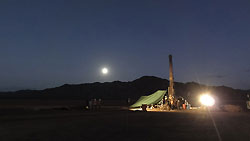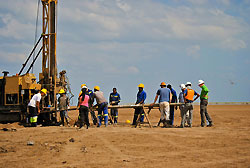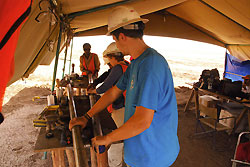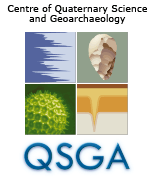The coring activities of the Chew Bahir Project, part of the Hominin Sites and Paleolakes Drilling Project (HSPDP) and associated with the CRC 806 have been successfully accomplished end of November after 5 weeks of field work in southern Ethiopia. About 3 tons of fine deposits have been recovered from the Chew Bahir terrestrial climate archive in the deep tectonic basin that represents the southern end of the Ethiopian rift and is covered by 2,000 km2 of saline mudflats. The field campaign, led by our Cologne colleague Frank Schäbitz and the Ethiopian, American and British cooperation partners and PIs that worked with an almost 40 strong international team at the site under difficult conditions, produced finally two overlapping cores from the south-western part of the basin. The cores comprise mostly fine lacustrine clays, with few sand layers and several potential tephra occurrences and macro fossils, that could already be identified in the science station in the field. A final depth of 278.58 mbs for hole 2A and 266.38 mbs for hole 2B could be reached with a recovery of 88.5 %.
Based on the results from the previous pre-studies, the cores are expected to provide valuable insights about the climatic history of at least the last 500,000 years from the source region of modern humans. Variations in the sedimentation rates within the basin suggest that the covered timeframe could also extend to maximal 1.4 Ma, but conservative calculations leave us still confident that the target interval of 0.5 Ma is covered by the cored deposits. Currently, the crates containing the sediment cores are processed through the ministry of mines to be then exported to the National lacustrine core facility in Minneapolis, where the material of the other 4 HSPDP subprojects are already being analyzed and processed.
 Night shift with full moon over the Hammar Range and the drill rig in operation. Night shift with full moon over the Hammar Range and the drill rig in operation.Photo: Frank Schäbitz |
 The day shift trying to pull the liner out with combined forces. The day shift trying to pull the liner out with combined forces.Photo: Frank Schäbitz |
 Measuring and labeling the liner in the science tent. Measuring and labeling the liner in the science tent.Photo: Frank Schäbitz |















